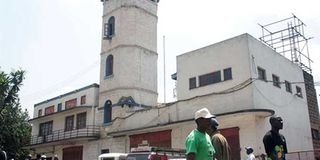Only 2 colonial-era fire stations are functional in Nairobi

The Nairobi fire stations on Tom Mboya Street. The city county government has only two functional fire stations which were built before independence. PHOTO | FILE | NATION MEDIA GROUP
What you need to know:
- The city, especially the informal settlements and markets, experience frequent fire outbreaks.
- A planned recruitment of 1,200 new firefighters last year flopped.
- In 2016, City Hall had only 10 fire engines, of which four were all second-hand.
The Nairobi City County government is yet to build its own fire station despite having amassed at least Sh1.6 billion in fire inspection revenue since 2013.
The entire Nairobi city, with a population of over four million people, has only two functional fire stations which were built before independence.
This is despite the capital city, especially the informal settlements and markets, experiencing frequent fire outbreaks that have left scores of people dead and others injured with properties worth millions of shillings destroyed.
FIRE INCIDENTS
Kenya National Fire Brigade Association (Kenfiba) Secretary-General Francis Liech says that between eight and 10 fire incidents are reported to the Nairobi County fire brigade control room daily.
The two operational fire stations are the one along Tom Mboya Street – built in 1907 – and another one at Industrial Area built in 1957.
There are two others which are currently under construction – one along Kangundo Road and another one in Waithaka – but all are all funded by the World Bank.
RECLAIMED
There is also one in Gigiri which was reclaimed last year from a private developer who had allegedly grabbed it and turned it into a garage.
According to records in a document presented by officers from City Hall’s Disaster Management and Coordination department while appearing before the Nairobi County Assembly Budget and Appropriation committee on Friday, the county government received Sh1.63 billion in fire inspection revenue between July 2013 and February 2019.
In the 2013/2014 financial year, the department recorded Sh144 million in annual revenue. This increased to Sh148 million the following financial year while in 2015/2016 financial year, Sh162.5 million was collected.
REVENUE COLLECTIONS
The annual collections almost tripled in 2016/2017 financial year to Sh433 million, Sh436.8 million in 2017/2018 while as at March 29, 2019, the collection stood at Sh308 million.
But despite the huge collections, City Hall director of Fire and Rescue Services Brian Kisali told the committee that the county government only has 52 fire engines and 120 trained fire fighters but 11 will retire this year and another 13 next year.
“We face three major challenges which affect the fire department’s service delivery. We have a shortage of manpower, a lack of proper enforcement because the inspectorate officers are very few and we also lack utility vehicles which are meant to be used by our officers when they go to train the community on fire-related issues,” he said.
RECRUITMENT
A planned recruitment of 1,200 new firefighters last year flopped despite reports that they had even undergone training.
Nevertheless, Mr Kisali said they are awaiting the proper reconstitution of a new County Assembly Public Service Board come July and that they are expecting to get 200 more firefighters.
In October 2017, the county was to receive 26 fire engines donated by Somati Vehicles NV, a Belgium-based company.
In 2016, City Hall had only 10 fire engines, of which four, all second-hand, were donated in August the same year by the Japanese government.
VOLUNTEERS
“We are currently training volunteers across the county and we are in contact with sub-county administrators to organise for more youth to turn out for trainings and join us where they will be given some allowance for their work,” said Mr Kisali.
Last year, County Disaster Management and Coordination Chief Officer Ann Mwenda said that out of 4,044 hydrants in Nairobi, only 103 are functioning with those mostly affected being along Thika Road.
She stated that the functional hydrants are at Safari Park (two), Koja, Globe roundabout, Runda, Kijabe Street, and three at Industrial area and James Gichuru Road. She added that World Bank is drilling boreholes to assist in providing water in places where hydrants have none.





